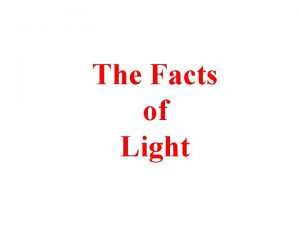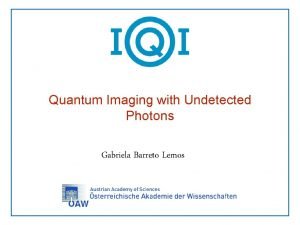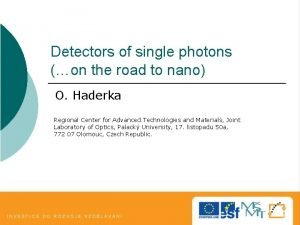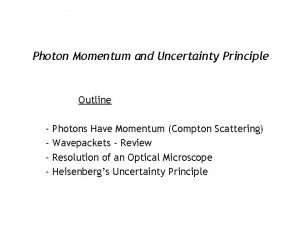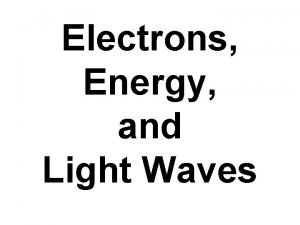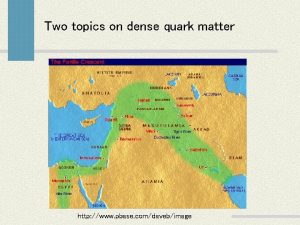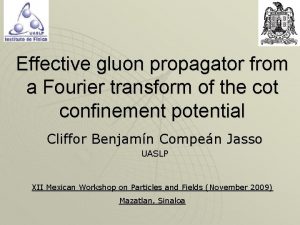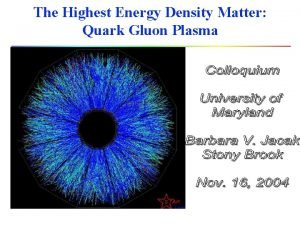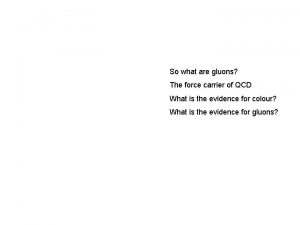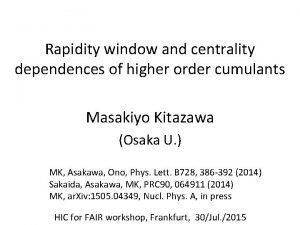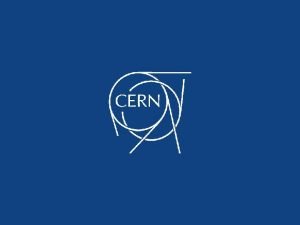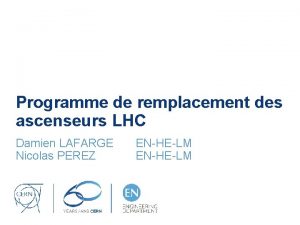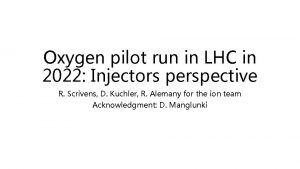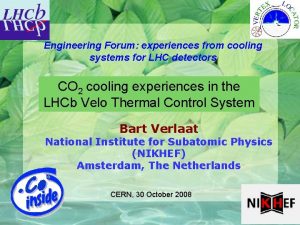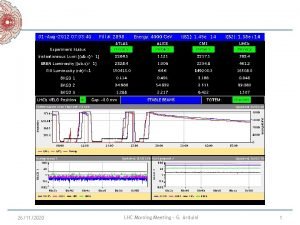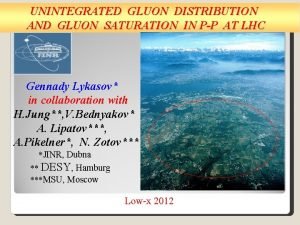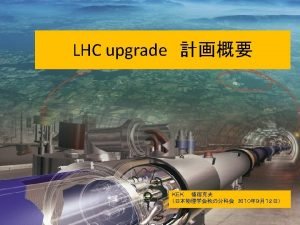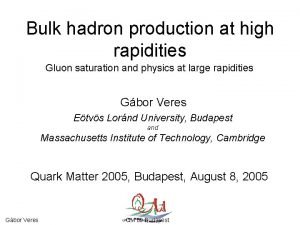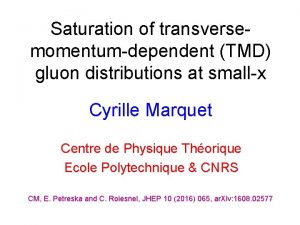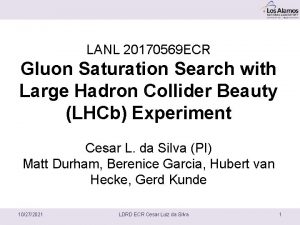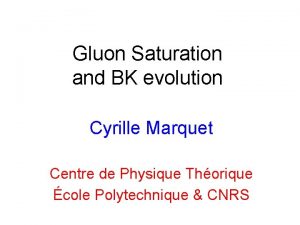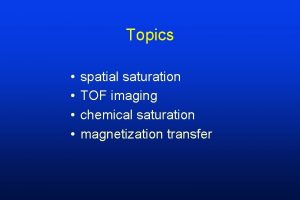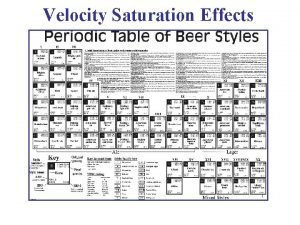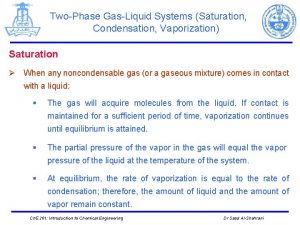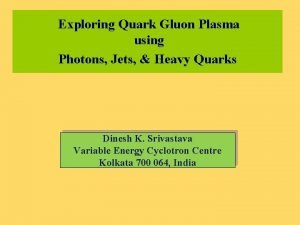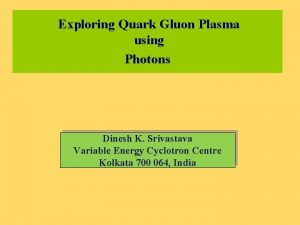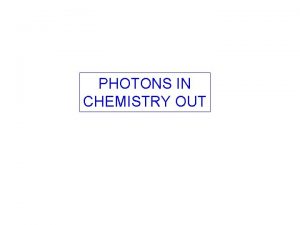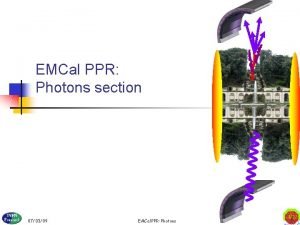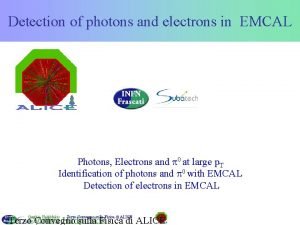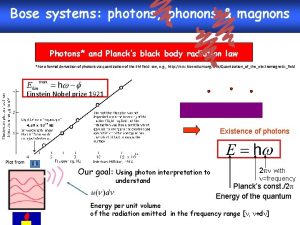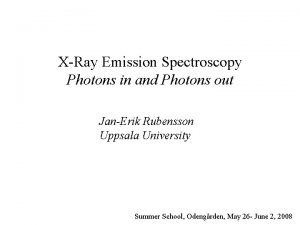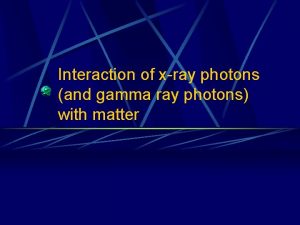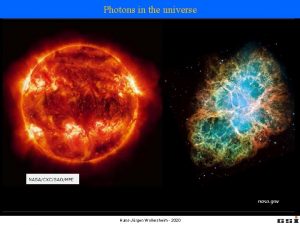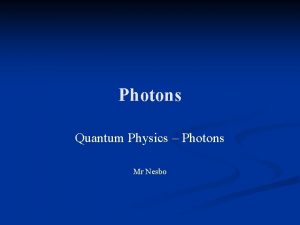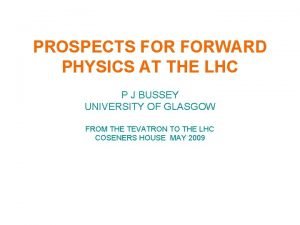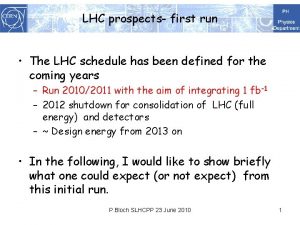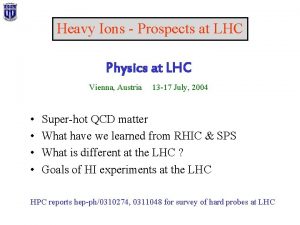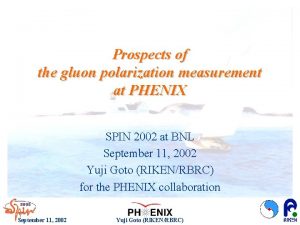Gluon saturation with forward photons at LHC prospects






























- Slides: 30

Gluon saturation with forward photons at LHC: prospects for a high-granularity calorimeter upgrade for ALICE Marco van Leeuwen, Nikhef and Utrecht University For the ALICE-FOCAL collaboration

Saturation/Color Glass Condensate Low x: large gluon density Low Q 2: large effective size of gluons Large theoretical interest: Strong fields, large occupation numbers • Fundamentally new regime of QCD • Theoretically calculable: Classical color fields; JIMWLK, etc Experimental/phenomenological question: Where/when is CGC dynamics relevant/dominant? Non-linear evolution ⇔Reduced gluon density ⇔Suppression of yield 1 + many instead of 2 → 2 ⇔Suppression of recoil jet (mono-jets? ) 2

Forward physics at RHIC Nuclear modification factor • Shadowing (n. PDF) gives smaller suppression • Qualitatively consistent with saturation – STAR, PRL 97, 152302 • Still low p. T; other soft mechanisms? 3

Forward di-hadrons at RHIC Minimum Bias d+Au collisions Central d+Au collisions STAR, Braidot, Ogawa et al. De-correlation of recoil yield associated Δϕ trigger –Consistent with CGC: coherent gluon field –What about multiple parton interactions? IMO: Much more compelling than inclusive suppression; could be ‘smoking gun’ 4

Di-hadron correlations at RHIC II 0 -�� 0 mid - forward �� Forward-Forward Mid-Forward 0 -20% (Central) PHENIX, PRL 107, 172301 60 -88% (Peripheral) |η| < 0. 35 and 3. 0 < η < 3. 8 Scan ‘x’ with p. T 1 and forward, mid rapidity More systematic study shows similar effects, trends as a function of x Large suppression at ‘x’ < 10 -3 in central events 5

ALICE Fo. Cal upgrade 0 RHIC fwd �� LHC vs RHIC LHC: x~10 -4 – 10 -5 accessible, RHIC forward: with p. T~Q~3 -4 Ge. V kinematic limit at p. T ~ 5 Ge. V 6

Recent results at forward rapidity ALICE J/Ψ measurement ALICE, JHEP 02, 073 New CGC calculation Ma, Venugopalan et al, ar. Xiv: 1503. 07772 More recent CGC calculation compatible with observed J/Ψ Compatible with n. PDFs + E-loss, but not CGC? Not yet conclusive; J/Ψ has sizable hadronisation/CNM uncertainties 7

Other recent forward results Muons from HF Rp. Pb ~ 1, compatible with n. PDF �� meson RFB != 1 No clear physics interpretation? 8

How to probe the gluon density Deep-Inelastic Scattering (DIS) Classical PDF method Not sensitive to gluons at LO Gluons from NLO/evolution and/or FL Photon production in hadronic collisions: Sensitive to gluons at LO Directly related to DIS: real instead of virtual photon 9

NLO studies of x sensitivity Helenius et al, ar. Xiv: 1406. 1689 �� reach factor ~10 lower x (can be improved with isolation cuts) Rp. Pb ~ 0. 85 expected from gluon shadowing n. PDFs Still: sizeable tail to x-distribution: mean x not most probably x how does this affect PDF constraining power? Could use theory guidance/help on this: How well does photon production constrain the gluon density at low x 10

The FOCAL proposal Under discussion within ALICE Fo. Cal-H 3. 2 < η < 5. 3 Fo. Cal-E: high-granularity Si-W calorimeter for photons and π 0 Fo. Cal-H: hadronic calorimeter for photon isolation and jets Observables: • π0 • Direct (isolated) photons • J/ψ • Jets Advantage in ALICE: forward region not instrumented; ‘unobstructed’ view of interaction point 11

Fo. Cal R&D: Si-W pixel and pad readout 20 layer pixel detector • Several groups involved: • • • Full prototype with pixel detectors CMOS (MIMOSA) 39 Mpixels, 30μm pitch Full prototype with pad readout Performed systematic tests: • Test beam data from 2 to 250 Ge. V (DESY, PS, SPS) • Cosmic muons Pad layer integration 12

Testbed results: Lateral shower profiles 50 Ge. V electrons Extremely good spatial resolution RM ~ 1 cm Comparison to Geant 4 simulations Good agreement with simulations GEANT 4 + charge diffusion Two-photon separation at mm scale possible 13

Photons n. PDF and CGC Main physics motivation Measure direct γ Rp. A to confirm or refute CGC effects n. PDF shadowing CGC expectation Direct γ is the flagship case Fo. Cal can measure • π 0 spectra • π 0 -π 0 correlations • γ -π 0 correlations which provide additional constraints CGC: Jalilian-Marian, Rezaeian, PRD 86, 034016 3. 5 < η < 4. 5 Should there be a return to Rp. Pb = 1 for p. T >> Qsat ? 14

Performance study: 0 reconstruction Use �� to reject decay photons 0 �� detection efficiency 0 with GEANT Single �� Very good efficiency > 90% p. T ~ 2 -18 Ge. V at η = 4. 0 -4. 5 NB: η = 5, p. T = 12 Ge. V ⇒ E = 900 Ge. V Covers the intended range for CGC measurements: low-intermediate Q 2 15

�� isolation: HCAL contribution Isolation energy distribution �� isolation is an important handle for �� identification HCAL helps with isolation: HCAL+ECAL energy peaks at 6 Ge. V instead of 0 Ge. V Full Pythia + GEANT MC: particle level (dashed curves) 16

Direct/decay separation Two main handles for direct gamma identification: Reject decays by invariant mass reconstruction Isolation cuts (EMCal + HCal) Direct �� /all cluster ratio Improve signal fraction by factor ~10, from 0. 01 -0. 06 to 0. 1 -0. 6 17

Projected direct photon uncertainties Direct �� • Large signal fraction at p. T > 10 Ge. V • • Uncertainties 5 -7% Low p. T: decay photons important • Uncertainties depend on physical direct/decay fraction Similar uncertainties expected for Rp. Pb: sensitive to CGC Rp. Pb ~ 0. 4 18

Fo. Cal physics program • p+Pb physics program: gluon density (+ridge) • • Rp. Pb of direct �� 0 Rp. Pb of �� Di-hadron measurements • Forward-forward: better constraints for low x • Mid-forward: ridge/flow-like effects Pb. Pb medium effects • • 0 at forward rapidity RPb. Pb of �� • Complementary to forward HF coverage; measure density, light flavour E-loss to calibrate models Mid-forward correlations — ridge effects, flow Plus a number of more challenging ideas: J/Ψ, jets, direct �� in Pb. Pb 19

Summary/conclusion • LHC forward physics provides unique opportunities for low-x physics in the short to medium term • • • Direct photons promise to be a very clean probe • • • First results on J/Ψ, φ, HF decay muons available from ALICE — no strong suppression seen in minimum bias events Rp. Pb for hadrons could be explored now by LHCb, (CMS, ATLAS) No fragmentation: access to lower x No final state effects ALICE is considering a forward calorimeter upgrade focused on • • 0 at forward rapidity (including correlations) �� �� at forward rapidity Input/discussion welcome: - Theory: explore sensitivity of direct photon production to low-x gluons - Experiment: new collaborators welcome! 20

Extra slides 21

More ‘known physics’: nuclear PDFs Q 2 = 1. 69 Ge. V 2 Q 2 = 100 Ge. V 2 C. Salgado et al. ar. Xiv: 1105. 3919 Nuclear modifications of PDF measured in DIS Gluon shadowing potentially large at x < 10 -3 Effect largest at low Q 2 Related to saturation/CGC or an independent phenomenon? 22

Reminder: how to get x and Q 2 in hadronic collisions LO 2→ 2 kinematics: Q ~ p. T Forward rapidity is small x LHC probes lower x than RHIC Mid-rapidity at LHC ≈ forward rap at RHIC (Need both final state partons to reduce spread in x) 23

x sensitivity pion vs gamma PYTHIA simulations Forward γ much more selective than π 0 γ -π 0 correlations provide additional constraints Pythia = LO + radiation NLO effects under study – expect small effect for isolated photons 24

x-ranges Direct �� , NLO contributions HF muons vs �� HF sensitive to larger x 10 -4 - 10 -3 Isolation reduces higher-x contributions Direct/isolation �� give clean access to lowest x ~ 10 -5 - 10 -4 25

Virtual photon production: Drell-Yan only sensitive to gluons at NLO DY: small cross section, not practical at LHC p+Pb 26

x, 2 Q coverage at LHC 27

Fo. Cal detector plan ECAL: Si-W Simulation uses current design • 20 layers, 1 X 0 each • Mostly pad layers 1 x 1 cm • 2 pixel layers after 5 and 10 X 0 Pixel layers for 2 -shower separation Pixel size in simulations: 50 um HCAL: Cu+Scintillator ~ 70 cm deep 28

Two-photon separation Simulated π 0 decay Granularity: ~500 μm Projection on separation axis Position resolution of ~ 1 mm achievable (2 -γ separation few mm) Energy resolution under study Unexplored regime for calorimeters: verify in testbeam 29

0 �� mass peaks, resolution 0 peak width �� High-granularity layers give excellent two-photon separation over large momentum range Peak width ~ 10 Me. V over large range in p. T 30
 Facts about photons
Facts about photons Quantum imaging with undetected photons
Quantum imaging with undetected photons Single photon detector
Single photon detector Momentum of photon
Momentum of photon Wavelength is equal to
Wavelength is equal to Quark gluon
Quark gluon Gluon propagator
Gluon propagator Quark gluon
Quark gluon Gluon plugin
Gluon plugin Quark gluon plasma
Quark gluon plasma Gluon force carrier
Gluon force carrier Quark gluon plasma
Quark gluon plasma Prospects preposition
Prospects preposition Quantum computing: progress and prospects
Quantum computing: progress and prospects Prospects of agriculture in bangladesh
Prospects of agriculture in bangladesh World population prospects
World population prospects The phrase elysian prospects suggests the
The phrase elysian prospects suggests the Rumus forward rate
Rumus forward rate Forward market adalah
Forward market adalah Lhc logbook
Lhc logbook Lhc location
Lhc location Lhc technical coordination
Lhc technical coordination Lhc:8001692
Lhc:8001692 Lhc intranet
Lhc intranet Lhc schedule 2022
Lhc schedule 2022 Lhc housing
Lhc housing Lhc plan
Lhc plan Forum lhc
Forum lhc Gant chart
Gant chart Lhc morning meeting
Lhc morning meeting Hl-lhc schedule
Hl-lhc schedule
